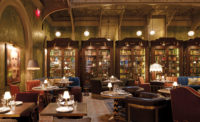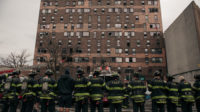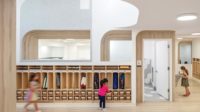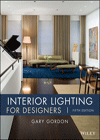The drama of Diller Scofidio + Renfro’s (DSR) master plan for the redevelopment of the Lincoln Center campus has been unfolding like a grand opera — with bold, crowd-pleasing gestures over several acts. Early in 2009, Phase One — Alice Tully Hall — reopened to rave reviews for its welcoming, daylit public spaces, its elegant theater notable for the brilliant acoustics by Jaffe Holden, and state-of-the-art lighting by L’Observatoire [record, June 2009, page 62]. A collaboration of DSR and FXFOWLE, the 150,000-square-foot project was part of the larger renovation and expansion of the Juilliard School building, completed later that year.
One of the world’s foremost performing arts conservatories, Juilliard had outgrown the physical and aesthetic limits of the 500,000-square-foot Brutalist structure designed by Pietro Belluschi (with Eduardo Catalano and Helge Westerann) in the 1960s. Like a travertine fortress, the building sat back from the street, with a remote, second-story main entrance accessible by way of a monumental stair on Broadway to the east or from the Lincoln Center plaza on the south via a wide bridge that overshadowed West 65th Street. Inside it was cramped and oppressive, with little sunlight. Its facilities were outdated, and much of the lighting hadn’t been upgraded since the building opened in 1969.
To engage Juilliard with its urban community, and vice-versa, the architects created a glazed four-level east wing extension that reaches over the Alice Tully Hall lobby like a luminous cantilevered proscenium, aligning with — not backing away from — Broadway. They infused the public areas with daylight by continuing the glazing along two levels of the south elevation, where it reveals a new street-side entrance, complete with a playful stair-cum-built-in grandstand seating. And they removed the bridge, replacing it with a crosswalk at grade, and a glass-walled balcony outside the second floor lobby/student lounge, which provides unimpeded views of Lincoln Center.
While the expansion adds approximately 39,000 square feet of classroom, studio, and office space, the architects’ introduction of transparency and light is what really impacts the tenor of the school. Working closely with DSR, FXFOWLE, the acoustician, and the Juilliard maintenance crew, the New York office of L’Observatoire developed a lighting scheme that is both pragmatic and dramatic.
According to lighting designer Jason Neches, the newly glazed south- and east-facing facades eliminate the need to turn lights on within adjacent interior spaces during the day, saving energy in the process. In the evening, however, the L’Observatoire plan lets the building shine. Linear fluorescent uplights, inserted into floor channels along the Broadway curtain wall, wash the fritted glass with a shimmering gauze of illumination. Directly beneath it, Neches and his team enlivened a vitrinelike dance studio — which juts out over the sidewalk — by edging the top of its longitudinal walls with T5-backlit panels of frosted glass. The result is a diffuse clerestory effect that keeps the 14-foot-high ceiling free of fixtures, a client specification. Another request from Juilliard was mood lighting. The school’s president, Joseph Polisi, often hosts dinners in this highly visible location. So Neches added dimmable rope lights behind the panels as an alternative to the T5s.
The lighting designers also transformed the box office next to the West 65th Street entrance into a “light box,” using a similar treatment of T5s behind frosted glass. Nearby, they lit the entry grandstand/stair as if it were a stage by directing ceramic metal-halide lamps, discreetly mounted into a tuck in the ceiling, onto the aspiring performers seated below. The stair appears to float, thanks to rows of T5s mounted on the back that bounce light around either side and through an opening at the stair’s base.
“We love uninterrupted planes of ceiling, and try not to penetrate them with too many downlights,” says Neches. When there is no option, he explains, “we try to make very small apertures.” For instance, he notes that his team used halogens in some lobby spaces for warmth and for their ability to dim and create multiple scenes. The acoustician specified halogens for the orchestra rehearsal room as well, in this instance to avoid interference with recording equipment. Moreover, to prevent buzzing, he stipulated a special lamp filament and dimming system. Special fixtures, modified for vibration, hang from the room’s structural ceiling and poke through — without touching — openings in a dropped, scrimlike acoustical panel ceiling.
Of all the project’s features, one of Neches’s favorites is a wood-lined reading room for viewing rare manuscripts. Here he and the architects tucked T5 lamps into coves that edge a central white ceiling band, indirectly illuminating the room. They then configured the room’s long table with custom LED task lights, deemed safe for the valuable documents.
Like a well-designed stage set, L’Observatoire’s strategy informs the work of DSR and FXFOWLE without dominating it. That’s because, Neches concludes, “we try to elevate the architecture without drawing attention to the lighting.”
People
Architect:
601 W. 26th Street, Suite 1815
Architect of record:
22 West 19th Street L’Observatoire International — Herve Descottes, Jason Neches, Nathalie Rozot, Beatrice Witzgall
Engineer(s):
Consultant(s):
Acoustical:
General contractor: |
Products
Lighting
Downlights:
Task lighting:
Exterior:
Dimming System or other lighting controls: |














